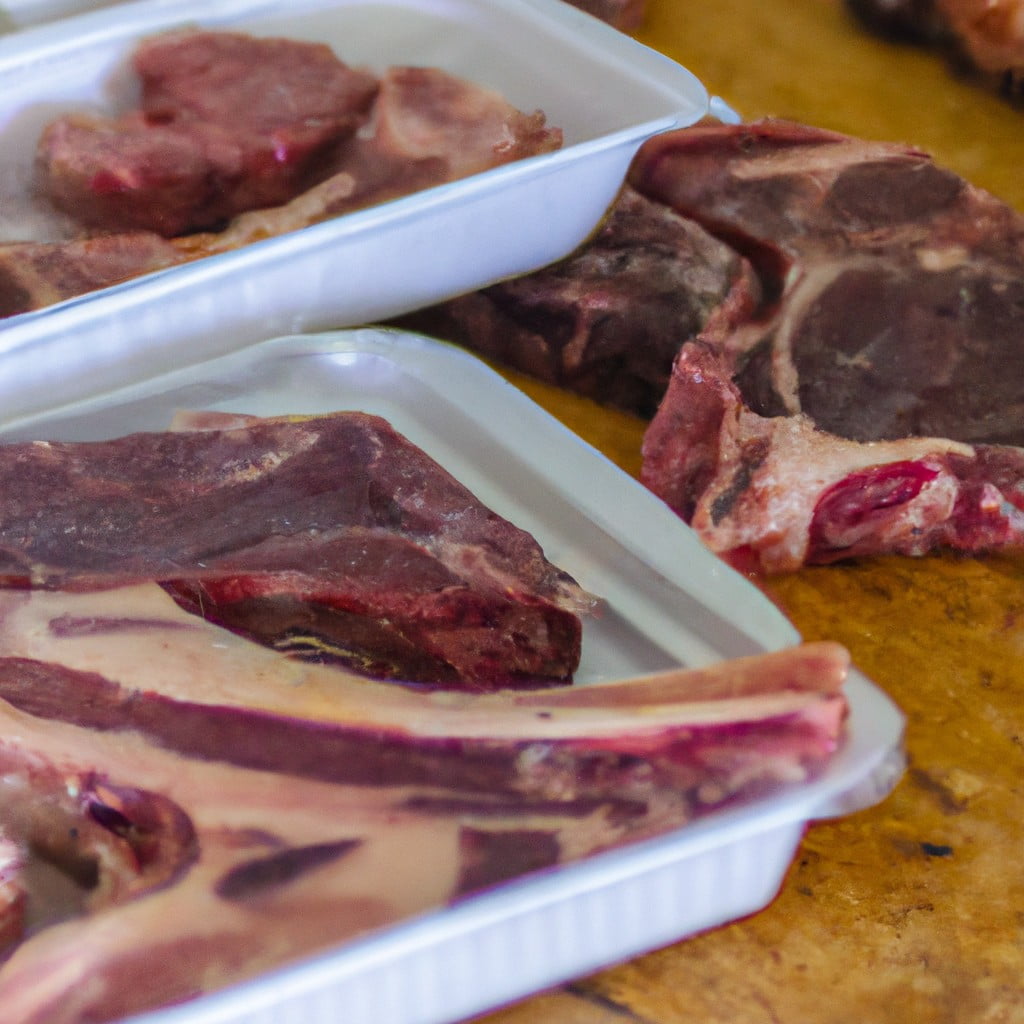Regenerative meat farming is a holistic approach that aims to improve animal welfare, bolster ecosystem health and reduce carbon emissions through sustainable practices.
Regenerative meat farming is a transformative approach to agriculture that goes beyond sustainable practices, aiming not just to do less harm, but to actively regenerate and improve the ecosystems it touches. This method integrates livestock and crops in a mutually beneficial cycle, resulting in healthier soil, more humane animal treatment, and more nutritious food products.
This article delves into the details of how this system works, the benefits it brings, and the challenges it faces. From the science behind soil regeneration to the economics of implementing these practices, we’ll explore the ins and outs of regenerative meat farming, providing a comprehensive understanding of this revolutionary approach to agriculture.
Key takeaways:
- Regenerative meat farming improves animal welfare, ecosystem health, and reduces carbon emissions.
- Key principles include soil health, animal welfare, biodiversity, and environmental impact.
- Regenerative meat farming draws from traditional agricultural practices and aligns with natural systems.
- It has a positive environmental impact, supporting biodiversity, carbon sequestration, and soil health.
- Regeneratively farmed beef offers nutritional advantages and enhanced taste and quality.
Look Inside:
Understanding Regenerative Meat Farming

Regenerative meat farming is a holistic approach to agriculture that aims to enhance the health of the entire ecosystem within the farm. It operates on several key premises.
First, it emphasizes the importance of soil health. Regenerative farming practices seek to improve and maintain soil fertility through methods such as rotational grazing, composting, and reduced tillage.
Next, it promotes animal welfare. Livestock under regenerative farming systems are given space to roam, graze, and express natural behavior, contributing to a healthier and less stressful life.
Moreover, it encourages biodiversity. By integrating different species and plant varieties, regenerative farms foster a more robust ecosystem that is less vulnerable to pests and disease.
Finally, it aims to generate a net positive environmental impact. By sequestering carbon in the soil and reducing the need for synthetic inputs, these farms can become part of the solution to climate change.
Knowing these underpinnings can help individuals make more informed decisions when purchasing meat products and can encourage farmers to adopt sustainable and regenerative methods in their operations.
Principles Behind Regenerative Meat Farming
Principles behind Regenerative Meat Farming revolve around five key ideas. First and foremost, the goal is to rejuvenate the soil. By rotating livestock, such as cattle, sheep, and chickens, farming helps regenerate grasslands and pastures, which naturally enriches the soil.
Another principle includes nutrient cycling. Livestock grazing on a diverse mix of plants and depositing their manure contributes directly to nutrient recycling. This process improves the soil’s fertility over time, enhancing the productivity of the land and the overall health of the ecosystem.
Integration of livestocks and crops is another staple. On a regenerative farm, livestock are not separate from the land; they’re an essential component of the system. They not only provide meat but also play a significant role in the health of the land, making them key participants in biodiversity enhancement.
Regenerative farming also emphasizes multi-species grazing. Different livestock species have different grazing patterns, which can help control unwanted plant growth, contribute to nutrient recycling, and aid in pest control.
Lastly, these practices respect the natural growth cycles of the livestock and ensure that the process remains humane. Animals are allowed to mature at a natural rate, living in conditions that suit their instincts and wellbeing, while also contributing to environmental sustainability.
With these principles, regenerative meat farming contributes to a more sustainable agricultural landscape, promising a considerable reduction in CO2 emissions, and tangible solutions to some of the pressing issues facing our food system today.
Historical Context of Regenerative Meat Farming
Regenerative meat farming springs from traditional methods that call for alignment with nature rather than opposition. It seeks to recreate the natural conditions in which animals thrive, without the need for synthetic inputs.
Contrary to the industrial model of raising livestock, this practice has deep roots in agricultural history, reflecting how our ancestors raised animals. The idea of pasture rotation in grazing, central to regenerative agriculture, was a common practice in early agrarian societies. It ensured animals had access to a variety of plants while preventing overgrazing and soil degradation.
Advancements in agricultural technology during the Green Revolution of the mid-20th century diverted many farmers from these time-tested practices. Now, with rising environmental issues linked to industrial farming, there’s a shift back to these historical principles, but backed by modern science, this time under the banner of regenerative agriculture.
Getting started with regenerative meat farming involves a few comprehensive steps:
- Understanding the natural behaviors of the livestock.
- Adapting farming practices to mimic natural ecosystems.
- Implementing pasture rotation for grazing animals.
- Involving livestock in the broader farm system, for example, using their manure as compost for growing crops.
- Continually monitoring and adjusting procedures depending on livestock health and soil quality.
Remember, regenerative farming isn’t just a set protocol or one-size-fits-all. It’s about understanding and working with nature’s intricate systems, and always striving for improvement.
The Environmental Impact of Regenerative Meat Farming
Regenerative meat farming differs significantly from traditional techniques largely due to its substantial positive impact on the environment. Firstly, it supports biodiversity, ensuring the co-existence of varying species within a single plot of farmland. This practice, in turn, aids pest control and enhances ecosystem resilience.
Furthermore, it takes aim at climate change by facilitating carbon sequestration. The rotational grazing techniques employed involve cattle herding in different sections of the pasture at different times. This encourages more robust grass growth which subsequently traps higher amounts of carbon dioxide from the atmosphere, aiding in greenhouse gas reduction.
Another advantage lies in soil health improvement. The cycling of animals across the land naturally incorporates manure into the soil, enriching it with organic matter. This promotes healthier, more fertile soil that’s able to retain more water. It reduces soil erosion and water pollution, making it a sustainable farming approach.
Lastly, regenerative meat farming diminishes the need for artificial fertilizers and chemical pesticides, reducing pollution and further contributing to a healthier ecosystem. Enhanced by natural processes, this method nurtures the productivity of the land rather than depleting it, forming the backbone of sustainable agriculture.
Adopting regenerative meat farming techniques, therefore, not only provides a source of sustainable meat, but additionally contributes to the overall health of our planet. Consumers can actively participate by purposely choosing regeneratively raised meat products, thereby supporting farmers who practice these environmentally friendly farming methods.
Nutritional Advantages of Regenerative Beef
Focusing primarily on regenerative farming can significantly enhance the nutritional profile of beef. This improvement can be attributed to the cow’s diet, exercise, and overall improved well-being.
Regenerative beef is often higher in certain vitamins, particularly Vitamin E and B Vitamins. These are vital for a wide variety of bodily functions, including energy production and maintaining healthy skin.
Additionally, beef from cows that have been grass-fed and managed regeneratively tends to contain more omega-3 fatty acids – beneficial fats known for their anti-inflammatory properties, which can contribute to improved heart health.
Conjugated linoleic acid (CLA) is another substance found in higher concentrations in regeneratively farmed beef. These compounds have antioxidant properties and may have various health benefits, including supporting weight loss.
Protein content in regeneratively farmed beef is usually similar to conventional beef, but the quality of protein can be higher. This is because it often contains a wider variety of amino acids – the building blocks of proteins, resulting in a ‘complete’ protein source.
In order to gain these nutritional benefits:
- Seek out regenerative meat producers and support them with your shopping dollars.
- Look specifically for “100% grass-fed” or “regeneratively-farmed” labels on beef products.
- Pick leaner cuts of meat, as even grass-fed, regeneratively farmed beef can still be high in saturated fat.
Remember, though, while regenerative meat farming offers these significant nutritional benefits, it is part of a bigger picture. Consider it one part of an overall approach to balanced nutrition. This method of farming isn’t just about producing healthier foods, but is about creating a healthier planet, too.
Improving Steak and Ground Beef Quality Through Regenerative Farming
Regenerative farming methods have a profound impact on the quality of the resulting steak and ground beef. These methods focus on restoring soil health, which in turn, enhances the nutritional value of the grass that cattle feed on.
Emphasizing Pasture Rotation: This strategy allows grasslands to rest between grazing periods, promoting the growth of a more diverse range of plant species. Cattle feed on these healthier, nutrient-rich pastures resulting in beef of superior quality.
Incorporating Diversity: By incorporating a diverse mix of livestock, such as sheep, chickens, and pigs, farmers can naturally control pests and diseases, reducing the need for antibiotics. This leads to healthier livestock and cleaner, tastier meat.
Reducing Stress for Animals: Less-stressed animals produce better-tasting meat. Regenerative farming provides cattle with more room to roam and access to fresh air and sunlight, all contributing to a significant reduction in stress.
Eliminating Growth Hormones: Regenerative farming practices cease the use of artificial growth hormones which have a direct impact on the flavor profile and quality of the meat. Through natural growth processes, the meat tends to have more favorable characteristics.
Practicing Humane Slaughter: The process of slaughter also affects the quality of meat. Stress hormones can taint the meat, so incorporating a humane, stress-free slaughter practice is integral to regenerative farming, improving the tenderness and flavor of the beef.
These practices are part of the regenerative farming method which aims to improve the quality of steak and ground beef, offering a product that is not only more delicious but also more beneficial for the health of consumers and the environment.
Sourcing and Purchasing Regenerative Meat
Sourcing regenerative meat necessitates a grasp of essential practices farmers use to raise their livestock:
Carefully managed grazing: Farmers ensure animals graze in a way that benefits the soil, mimicking the way wild herds would naturally roam and graze.
Animal-produced fertilizers: Instead of chemical fertilizers, regenerative farmers utilize the manure and urine from livestock to enrich the soil.
A diversified ecosystem: Regenerative livestock farms often house several animal species, ensuring higher biodiversity, which contributes to overall land health.
To find and buy regenerative meat, these following steps can guide you:
Local farmers markets: Here, you can buy directly from farmers, who can provide details about their farming practices.
Online sources: Several websites specialize in selling meat from farms with regenerative practices.
Meat delivery services: Some services focus on sustainable and regenerative sources, delivering directly to your door.
Consult the ‘Eatwild’s State-by-State Directory’: An online resource that lists farmers and stores practicing regenerative farming can be found on the Eatwild website.
Remember, asking questions is crucial when seeking to purchase regenerative meat, about the farm’s practices, animal diets, grazing methods, and more. While it might require a little more effort, the benefit to our health and the environment makes each step worthwhile.
FAQ
What is regenerative farming meat?
Regenerative farming meat refers to the meat obtained from animals that graze on nutrient-rich, naturally grown grass, thereby producing more nutritious and sustainable produce.
Why is regenerative agriculture not good for farmers?
Regenerative agriculture can impose challenges on farmers, including the need to learn new skills, an increase in unwelcome plants due to less tilling, and a potential increase in herbicide use.
What animals are best for regenerative agriculture?
The best animals for regenerative agriculture are traditional livestock such as cattle and pigs, along with fowl like chickens, ducks, and geese due to their pest management benefits, and their health and disease resistance can be boosted by making available free-range minerals.
How do regenerative farmers make money?
Regenerative farmers make money by obtaining higher premiums for their crops through certifications, marketing their grain directly to consumers as seed or feed, and utilizing their fields for various crops beyond corn.
How does regenerative farming mitigate climate change?
Regenerative farming mitigates climate change by sequestering carbon in the soil, reducing greenhouse gas emissions, and improving ecosystems’ resilience to climatic extremes.
What essential elements must be in place for farming to be considered regenerative?
For farming to be considered regenerative, it must actively improve the soil’s health, increase biodiversity, promote ecosystem resilience and longevity, engage in holistic land management, and prioritize the welfare of all species involved.
What are the economic impacts of shifting from conventional to regenerative agriculture?
Shifting from conventional to regenerative agriculture improves long-term economic prosperity by reducing input costs, stabilizing yield performance, building resilience against market and climate uncertainties, and creating new revenue opportunities through market demand for sustainably grown products.




